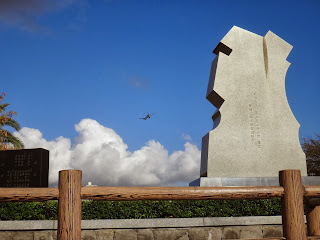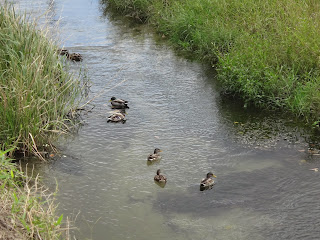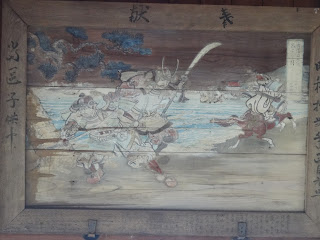One nice thing about Japan is that new buildings are generally required to have access for people in wheelchairs. This apartment building has both stairs and a ramp.
This rather artistic building is a pachinko parlor. From the looks of its parking lot on the right, it is a busy place.
In the window of an auto dealer, I found this collections of models of the models.
Nov 30, 2013
Nov 29, 2013
Along Nakagawa, Naka River
Lunch time.
Still major construction going on on the river to repair the damage from last years flooding.
Today, I found that there is a five kilometer walking course that starts at Hakataminami Station and returns there. If I start at my apartment and do not go to the station, it is about 4 kilometers, perfect for my exercise. This is a sign that is painted on the sidewalk at an intersection. The arrow shows the direction to go, below that is a warning to be careful when crossing, then in green it says 'walking course', finally there are footprints a widespread symbol indicating that you should stop and wait for the light.
Still major construction going on on the river to repair the damage from last years flooding.
Today, I found that there is a five kilometer walking course that starts at Hakataminami Station and returns there. If I start at my apartment and do not go to the station, it is about 4 kilometers, perfect for my exercise. This is a sign that is painted on the sidewalk at an intersection. The arrow shows the direction to go, below that is a warning to be careful when crossing, then in green it says 'walking course', finally there are footprints a widespread symbol indicating that you should stop and wait for the light.
Nov 28, 2013
Strange things
This tree was in a yard next to the path along Kajihara River. As I approached I could see that there were green balls hanging in the tree. They were about the size of the Christmas tree ornaments that we had when I was a kid.
I think that the fruit was some kind of mikan, Japanese tangerines, but I am not sure.
After walking away from the river, I passed the office of a specialist in children's medicine. This was outside, beside the door. I thought it was kind of cute.
Nov 27, 2013
A Birdfield
Often when I go out for an exercise walk, I arrange my route so that I can follow the streamside path. By the way I have finally found out the name of the stream, kajiharakawa, or Kajihara River or Mulberry Field River if you look at the meaning of each kanji.
As I walked by the stele commemorating the Antoku Park, I noticed that it looked a bit different.
As I walked by the stele commemorating the Antoku Park, I noticed that it looked a bit different.
On this day it had turned into a birdfield, with pigeons rather than airplanes.
Nov 26, 2013
Weed hacking along the stream
On another day, I walked along the stream. I am trying to get back in shape after my operation so I tend to walk the same route every day. On this day the grass was being cut.
One thing that is very noticeable about Japanese workers is that they always wear a safety helmet. Even visitors to a site are required to wear a helmet.
The birds seem very happy with the work, since it has forced all of the small bugs and animals that they eat out into the open.
One thing that is very noticeable about Japanese workers is that they always wear a safety helmet. Even visitors to a site are required to wear a helmet.
The birds seem very happy with the work, since it has forced all of the small bugs and animals that they eat out into the open.
Nov 25, 2013
On the way home
This is the edge of a large park and it shows a typical scene. When they have to cut down a tree for some reason, the stump is left with to just rot away. Sometimes they will start growing again, but usually they will just gradually fade away. This one is being slowly covered with some sort of vine.
This is a stele commemorating the establishment of the park. It is named after one of the Emperors, Antoku, who was said to have been in this area after advocating. There is a very active historical society in this town and my wife and I are thinking about joining it. Also in the picture, right in the center is an airplane that is in the process of landing at Fukuoka Airport, which is less than 10 kilometers away.
This is part of the path along the riverside.
This is a stele commemorating the establishment of the park. It is named after one of the Emperors, Antoku, who was said to have been in this area after advocating. There is a very active historical society in this town and my wife and I are thinking about joining it. Also in the picture, right in the center is an airplane that is in the process of landing at Fukuoka Airport, which is less than 10 kilometers away.
This is part of the path along the riverside.
Nov 24, 2013
More birds
The stream is the home to an amazing number of birds, particularly ducks at this time of year.
The birds long the rivers show how close we are to the countryside. My apartment is in a built up area with lots of stores and companies, but there are many birds along the river. The numbers increase as you approach the hills.
This is one of the last pictures I will have of the grass growing along the stream. Construction workers are taking out the vegetation and the build up of sand. Also I was talking about the nearness of the countryside. In this picture you can see how close the uninhabited mountains are.
The birds long the rivers show how close we are to the countryside. My apartment is in a built up area with lots of stores and companies, but there are many birds along the river. The numbers increase as you approach the hills.
This is one of the last pictures I will have of the grass growing along the stream. Construction workers are taking out the vegetation and the build up of sand. Also I was talking about the nearness of the countryside. In this picture you can see how close the uninhabited mountains are.
Nov 23, 2013
For the birds
In a low spot on the side of the paved path away from the river, there was a rice paddy. As I went by, a flock of pigeons decided to leave.
In the river there were ducks
I left the riverside and head back to my apartment. This little house on a large lot was surrounded by what I guess should be called a rock garden. There were some large plants and bushes but there were even more large rocks carefully placed around the grounds.
In the river there were ducks
I left the riverside and head back to my apartment. This little house on a large lot was surrounded by what I guess should be called a rock garden. There were some large plants and bushes but there were even more large rocks carefully placed around the grounds.
Nov 22, 2013
Work along the Nakagawa River
This sort of trash burner is not common in Japan. I think it is because neighbors complain about the smell. Mostly the only open fires that you see are when they burn off the extra straw from the rice paddies.
The flooding last summer, before we got here, was the impetus for a major construction project along a many kilometer stretch of Nakagawa River. (That is interesting gawa means river in Japanese, so in reality I just wrote 'Naka River River'.) Here they are widening the riverbed. The large stones have been moved out into the river while they work. It will be interesting to see what they do with them when they finish.
A major part of the work is removing the sand that appears to have been deposited by the flooding. I did not seen the river before the flooding so I am not sure, but that appears to be at least part of what they are doing.
The flooding last summer, before we got here, was the impetus for a major construction project along a many kilometer stretch of Nakagawa River. (That is interesting gawa means river in Japanese, so in reality I just wrote 'Naka River River'.) Here they are widening the riverbed. The large stones have been moved out into the river while they work. It will be interesting to see what they do with them when they finish.
A major part of the work is removing the sand that appears to have been deposited by the flooding. I did not seen the river before the flooding so I am not sure, but that appears to be at least part of what they are doing.
Nov 21, 2013
A longer way
It was cloudy but the sun was shining through creating a beautiful view over the mountains. Also I finally figured out where I was. When I left the last shrine, I had walked northwest instead of west and ended up on the right river but a couple of kilometers north of where I had expected to meet it.
Along the riverside there was a park with some very nice sitting areas. The river is about 15 meters to the right.
It appeared that they were building a new bridge. The bridges in this part of the river are separated by a quite large distance.
Along the riverside there was a park with some very nice sitting areas. The river is about 15 meters to the right.
It appeared that they were building a new bridge. The bridges in this part of the river are separated by a quite large distance.
Nov 20, 2013
Starting for home
I started walking toward what I thought was the west, toward the rivers. This rather fantastic looking tree appeared. I love the unbalanced look from where they trimmed branches away from the power and telephone lines.
I reached the river at spot I had never been to before. I found this large moveable dam next to a bridge. The blue portion can be lowered into the water to create a temporary dam.
These apartment building (they look like public housing, but I am not sure) had strange abstract designs on the ends facing the street.
I reached the river at spot I had never been to before. I found this large moveable dam next to a bridge. The blue portion can be lowered into the water to create a temporary dam.
These apartment building (they look like public housing, but I am not sure) had strange abstract designs on the ends facing the street.
Nov 19, 2013
A last look at the shrine
A last look at the shrine before heading home. You can see two of the decorative bolt covers that I showed yesterday. They are at the top center where the post and lintel come together.
The Fukuoka International Airport is near the center of the city, three of four short subway stops.
Often in Japan, large areas are not at all picturesque, but there are always little spots of beauty.
The Fukuoka International Airport is near the center of the city, three of four short subway stops.
Often in Japan, large areas are not at all picturesque, but there are always little spots of beauty.
Nov 18, 2013
More of the shrine
Another view of the open area in the building. I was very surprised at the number of paintings.
One of the trees has a very stringy shimenawa.
The wooden timbers that make up the frame of the shrine buildings are held together with large bolts and the ends of the bolts are covered with ornate brass fittings. The ends of the timbers are protected from the weather with a thin metal covering. This covering of the ends of pieces of wood is very common in Japan. You see this on structures large and small, from bird houses to bridges.
One of the trees has a very stringy shimenawa.
The wooden timbers that make up the frame of the shrine buildings are held together with large bolts and the ends of the bolts are covered with ornate brass fittings. The ends of the timbers are protected from the weather with a thin metal covering. This covering of the ends of pieces of wood is very common in Japan. You see this on structures large and small, from bird houses to bridges.
Nov 17, 2013
More pictures at the shrine
The shrine from the front.
These are the seven Chinese gods, who are now completely Japanese. Benten, one of them, is enshrined here. He is the one in the reddish brown kimono.
This is apparently some historic Japanese military hero.
These are the seven Chinese gods, who are now completely Japanese. Benten, one of them, is enshrined here. He is the one in the reddish brown kimono.
This is apparently some historic Japanese military hero.
Nov 16, 2013
At the front of the shrine
I walked out to the front of the shrine because I noticed the house directly across the street from the entrance. It was a large, traditional style building with a modern gate.
I turned around and looked back into the shrine grounds.
The sign at the right in the last picture contained a lot of information about the shrine. It lists the four gods who are enshrined here, the person responsible for the shrine, and a brief explanation about the gods.
I turned around and looked back into the shrine grounds.
The sign at the right in the last picture contained a lot of information about the shrine. It lists the four gods who are enshrined here, the person responsible for the shrine, and a brief explanation about the gods.
Nov 15, 2013
More from the shrine
This is another picture from under the eves of the shrine.
This is looking toward the entrance to the altar building.
This stele also plastic covered straw ropes. I thought it looked a bit like a ghost.
This is looking toward the entrance to the altar building.
This stele also plastic covered straw ropes. I thought it looked a bit like a ghost.
Nov 14, 2013
Still at the shrine
In the wall-less room, there was a small altar with the doors open. Inside was a statue of a man, god or important figure? I don't know.
Up near the ceiling of the same room, there were paintings. From the way they have aged, I would guess them to be fairly old. This picture shows a small boat with three men in it and the moon very prominent in the background. This probably relates to some fable related to the shrine.
You can just see the above picture on the right under the ceiling. The entrance to the altar building is on the left.
Up near the ceiling of the same room, there were paintings. From the way they have aged, I would guess them to be fairly old. This picture shows a small boat with three men in it and the moon very prominent in the background. This probably relates to some fable related to the shrine.
You can just see the above picture on the right under the ceiling. The entrance to the altar building is on the left.
Subscribe to:
Posts (Atom)



















































